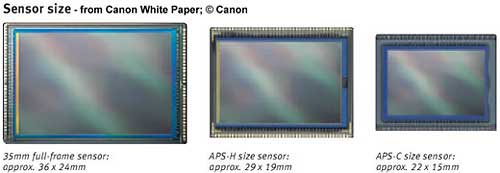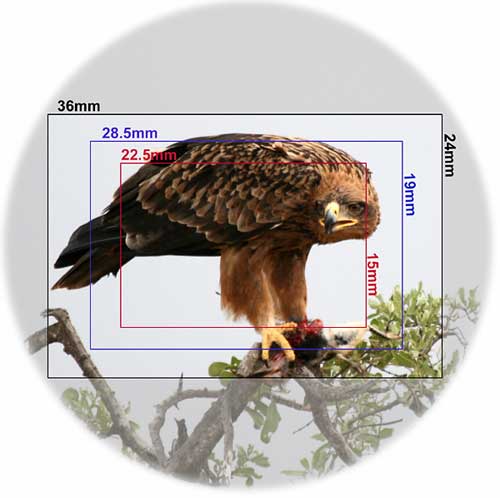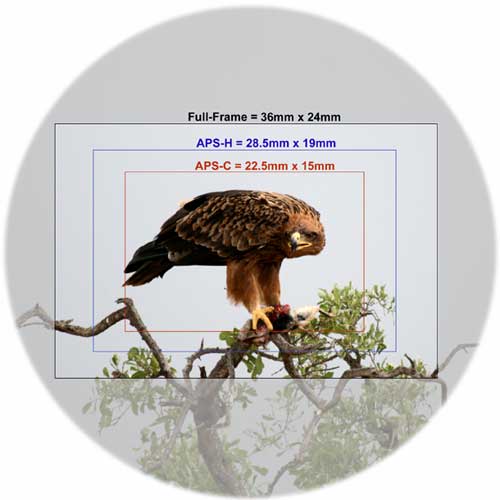Contact Details: Scotch Macaskill, Dirt Road Traders, Currys Post Road, Howick, KwaZulu-Natal, South Africa. Tel: +27 (0)82 578 2329. Privacy: Your privacy is guaranteed. See our Privacy Policy for more. This site accepts advertising and other forms of compensation - see Disclosure and Advertising for details. Site updated: 2022. Copyright © 2002 - 2022 Scotch Macaskill

| ||||||||||
|
||||||||||
|
See Also: |
Canon Crop FactorCanon digital SLR cameras are fitted with one of three different sensor sizes, depending on the model:

Lenses made for traditional 35mm SLR cameras are designed so that the circular image cast by the lens fully covers the rectangular area of the film. If the same lens is attached to a full-frame digital camera, the image will similarly cover the area of the sensor. However, if you replace the full-size sensor with a smaller one (sub full-frame), some of the image will "overflow" as the size of the image will be bigger than the sensor. So a portion of the image, along the top, bottom, and sides, will "spill" over the edges of the sensor and be lost. See diagram below, where the black rectangle represents a full-frame sensor (36 x 24mm in size), the blue rectangle represents an APS-H sensor (28.5 x 19mm in size), and the red rectangle represents an APS-C sensor (22.5 x 15mm in size) (Note: sensor sizes not to scale).
Now attach a Canon 600D (Rebel T3i) to the lens and even more of the eagle falls outside the sensor (red rectangle), cropping off significant bits of the bird. Okay, let's take a second scenario, with the same eagle (amazing how it holds its pose!), but this time using a 200mm lens. When
attached to the 5D Mk II body, notice how much space there is around the eagle (black rectangle). Switch to the 1D Mk III body, and it looks
like we've zoomed in tighter (blue rectangle).
Crop FactorThis cropping of the image caused by the smaller, sub full-frame sensor is referred to variously as "crop factor", "lens magnification factor" or "focal length conversion factor". Call it what you will, in practice when you fit a regular Canon EF lens to a digital camera with either an APS-C or APS-H sensor, your subject will fill more of the sensor -- mimicking what would happen if you used a tele converter or switched to a longer lens on a full-frame camera. The crop factor on Digital Rebels and the Canon 40D/50D/60D range is 1.6x, while that for the EOS 1D line-up is 1.3x. So if you're using a 200mm lens on a Canon 600D, you'll get the same magnification as you would using a 320mm lens on a Canon 5D Mk II (200 x 1.6). On the Canon 1D Mk III, it's like using a 260mm lens (200 x 1.3). The crop factor is a huge bonus for anyone using telephoto lenses such as wildlife and sports photographers. Fitting a lens like Canon's EOS 70-200mm f2.8L IS on your 600D or 60D body is like shooting with a 112-320mm f2.8 image-stabilized zoom. Such a lens, if produced by Canon, would cost about the same as a small car! But it's just the opposite for landscape and architectural photographers -- or anyone who shoots predominantly with wide angle lenses. Now that incredible 16-35mm ultra wide angle zoom that produces such striking images has been "lengthened" by 60% -- and now is equivalent to a rather mundane 25-56mm wide angle zoom. It's for this reason that Canon has recently added a number of EF-S lenses to its range. These are specifically designed for Canon digital SLRs with the APS-C sensor and are aimed at countering the magnification factor on the wide angle side. A good examples is the Canon EF-S 10-22mm f/3.5-4.5 USM, which equates to a 16-35mm ultra wide on a full-frame body. Return to Canon Lens Reports |
|||||||||
|
|
||||||||||

